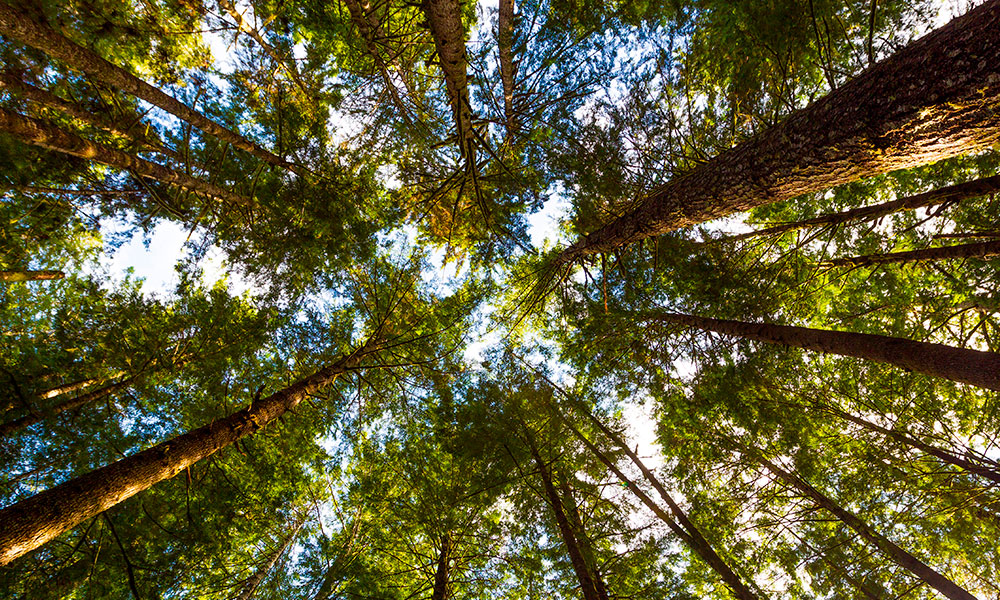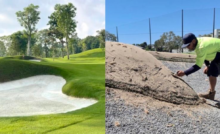Thoughtful tree planning


Hemlock Trees
To the novice golfer or average club official, planting a tree on a golf course seems fairly straightforward. After all, it only takes a short trip to the nursery and 10 minutes to dig a hole. Well, not exactly. An improperly placed tree of the wrong species can seriously interfere with the original intent of the course architect, or even worse, completely destroy a putting green. The following are 10 guidelines that one should ponder before attempting to plant a tree. Hopefully, these guidelines will help ensure that a new tree becomes an asset to the entire club rather than a thorn in the superintendent’s side.
Before reviewing these guidelines, please realize that each may not always apply strictly in all situations. For example, large trees planted 25 yards from a putting green on the south side will cause greater problems than a tree planted the same distance on the north side, due to heavy shading.
Guideline No. 1
Make sure to select a planting location so that the mature canopy of the tree will not protrude on the line-of-flight between a tee and a fairway. Trees with protruding limbs dramatically reduce the usable size of a tee.
For example, a tree planted too close to the front right-hand side of a tee will promote concentrated use on the left-hand side of the tee. The result of such concentrated divoting on one side of the tee usually promotes discussion about the superintendent’s abilities. The solution to large overhanging limbs is usually sympathetic pruning that leaves the tree permanently disfigured. Actually, complete removal of a tree could be the best solution.
Guideline No. 2
To allow for vital air movement and exposure to sunlight, resist the temptation to plant dense groves of trees around greens, tees, and fairways. Poor air circulation, especially in areas where greens are located produces soaring temperatures and humidity during the summer that in turn promotes harmful disease development. Furthermore, poor air circulation and dense shade during the winter produces cooler soil temperatures that severely retards the growth rate, leaving greens helpless against foot traffic. In situations where poor air circulation and restricted sunlight penetration cause unacceptable turf loss, tree removal is absolutely necessary.
Guideline No. 3
Never try to completely fill in rough areas between adjacent fairways with trees for the sake of safety. No matter how many trees you plant to protect neighboring players, the odds are the first high handicapper will find a way through. Once they do, look out. The player automatically feels qualified to join the PGA Tour and aims directly into the oncoming players, hoping to hit a fade back over the trees.
If your intent is to protect players in adjacent fairways, then plant groups of tees strategically near the tee. This will prevent errant shot from even having a chance to stray. Leave several openings between adjacent fairways near the landing area so that if some do stray, they have the opportunity to return to their fairway uninhibited.
Guideline No. 4
Never plant large trees closer than 75 feet from a green or tee, because they will become serious competitors for available water and nutrients. Most individuals are under the mistaken impression that tree roots cannot extend outward from the trunk further than the drip line of the tree. In reality, tree roots can extend outward from the tree trunk approximately one to one and a half times the total height of the tree.
For example, if a tree is 100 feet tall, its roots can extend as far as 100-150 feet. Once tree roots have invaded underneath a green or tee, they sap water and nutrients away due to their overwhelming size. In situations where tree roots are a problem, sever them with a trencher and install a permanent barrier.
Guideline No. 5
Without question, flowering trees add unmistakable beauty to any course. However, due to their tender bark and dwarf stature, they are extremely sensitive to mower damage. This sensitive nature makes most flowering trees poor candidates for use on a golf course unless they can be carefully protected. Augusta National is a good example. The beautiful flowering dogwoods and azaleas have been planted underneath large pines where there is never an occasion to operate heavy mowing equipment.
Guideline No. 6
Try to avoid screening out scenic vistas. Scenic vistas include the clubhouse, ocean or mountain views, lakes or other open areas of the course. Once a scenic vista has been lost, it is usually forgotten and consequently may be lost forever.
Guideline No. 7
It is often best to avoid using a standardized tree planting as yardage indicators. Problems arise in the future when one of the plantings is lost or damaged. For example, if palm trees are used on each hole to indicate a distance of 150 yards, it will be impossible to replace a dying palm with one of matching size. In addition, a tree planted to the edge of a fairway can severely penalize a golfer.
A better means of indication yardage may be to mark large, landmark trees already present throughout the course with small wooden or metal plaques. The advantage of marking landmark trees is that they blend in with the course surroundings, they are already present throughout the course, and because of their size, they can be seen by golfers that stray into adjacent fairways.
Guideline No. 8
When selecting trees, choose species that match the existing vegetation and have favorable characteristics. Cottonwoods and large fruit trees are not good candidates for golf courses because they are strong surface rooters or require continuous maintenance.
In addition, try to limit the number of different species as much as possible. A continuous vegetation scheme is often the trademark of many of America’s highest ranked courses. An example is Oak Hill Country Club in Rochester, New York. This particular course has a continuous theme of oak trees from the first tee through the 18th green. Courses that tend to plant a potpourri of tree species are usually unflatteringly referred to as tree zoos or specimen parks.
Guideline No. 9
Try to naturalize the appearance of large tree plantings by randomizing the distance between each tree. A good way to develop a randomized tree planting would be to hit several dozen golf balls into a rough area from a distance of 200 yards. Then place a small flag where each ball has landed and selectively remove one flag at a time until there are an appropriate number left.
Guideline No. 10
To prevent unnecessary neglect of newly planted trees, never plant more than the maintenance staff can adequately maintain. During the first year of establishment, small trees require extra attention and frequent hand-watering during the summer. If you must purchase trees in large numbers due to cost, it might be easier to establish a tree nursery near the maintenance facility where they can be easily cared for. Then, over the next several years, spread them over the course.
Summary
Remember that a good tree planting program on any course starts with a long range plan. What makes a golf course different from a park or your front yard is the presence of sensitive putting greens and the integrity of the game.
The agronomic impact of misplaced trees is commonly seen in the form of shade, root competition and poor air circulation. Thoughtful tree planting should not only improve the appearance and playability of your course, but more importantly remove those thorns from your superintendent’s side.
Printed with permission from the American Society of Golf Course Architects
www.asgca.org
Recent Posts
Memphis Country Club: A Golfer’s Study in Precision and Tradition
If you have ever teed it up at Memphis Country Club, you know this isn’t…
Foley Company attains GCSAA Silver Partner Status
Foley Company, a leader in turf equipment innovation and technology, affirms its support of the…
Harrell’s continues longstanding support of the GCSAA Foundation
Harrell’s LLC, a leading distributor of customized agronomic products for turfgrass since 1941, has donated…
City of Orlando Announces New State-of-the-Art Driving Range at Dubsdread Golf Course
The City of Orlando is excited to announce the construction of a brand-new, state-of-the-art driving…
Discover Puerto Rico for Great Golf Trips and After-Round Activities, Amenities
Golfers cannot live by the game alone which is why Puerto Rico provides the perfect…
Q&A with a Multi-talented Golf Course Architect – Part 2: Making the Rounds – Installment 39
This column features recollections of the author’s 37 years as a golf writer. These installments…


